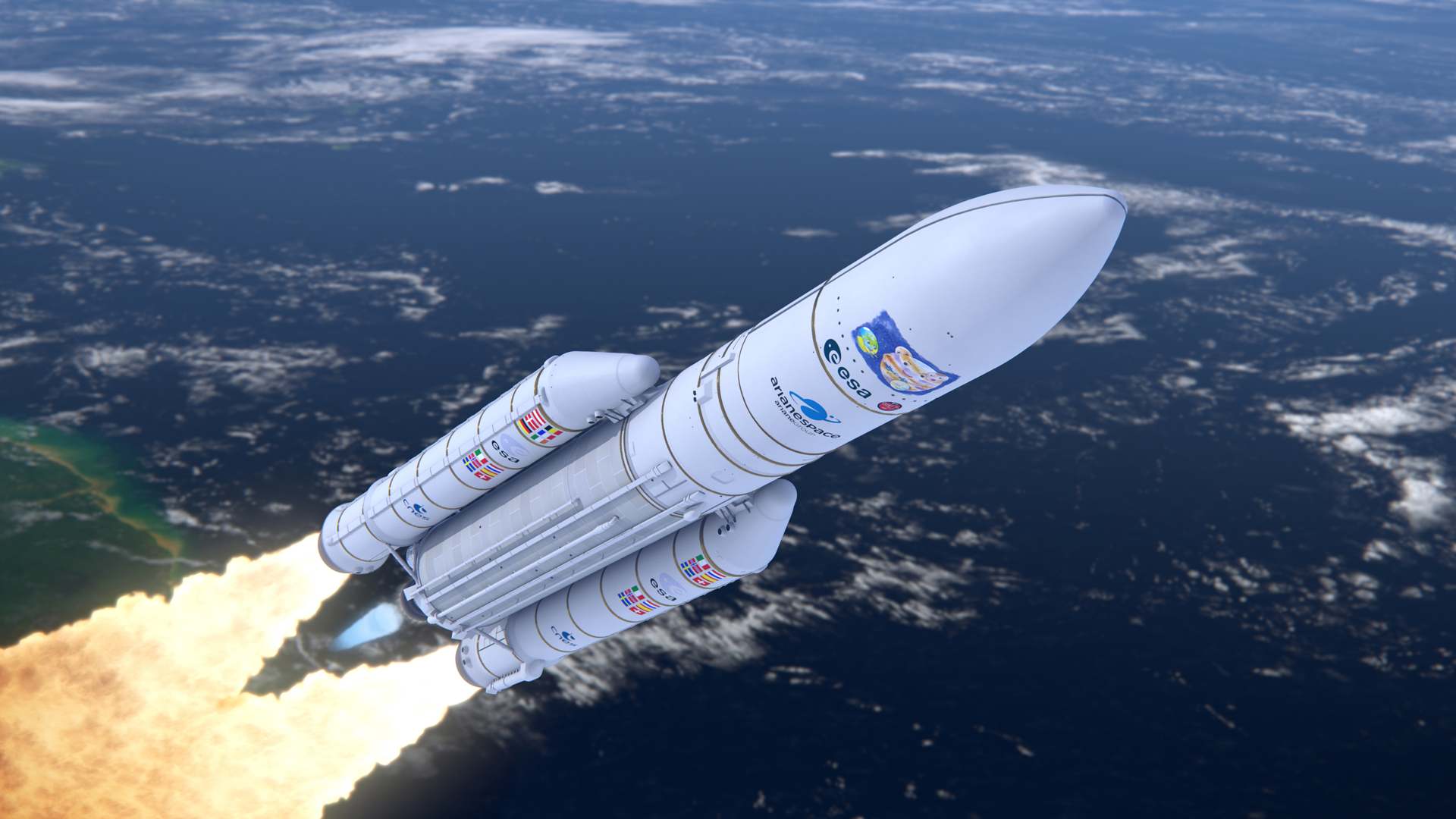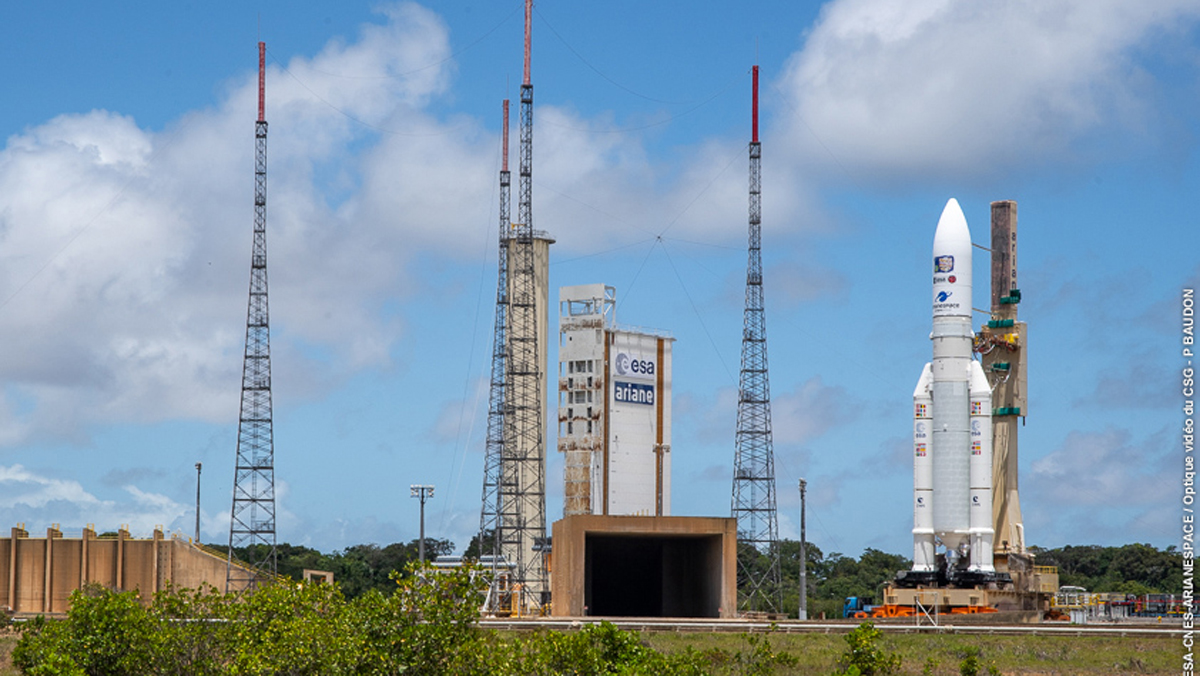Europe's JUICE mission has to squeeze into a 1-second launch window. Here's why.
JUICE needs the universe to align so that it can get to Jupiter with as little fuel as possible.

Editor's note: ESA has postponed the launch of its JUICE Jupiter mission due to the risk of lightning at the launch site. The launch is now scheduled for Friday (April 14) at 8:14 a.m. EDT (1214 GMT).
Europe's upcoming Jupiter mission has only one second a day in which it can launch and hit the correct trajectory that will take it to the gas giant planet in eight years' time. Fortunately, the mission will have one of these one-second windows each day until the end of April.
The universe truly has to align for the European Jupiter Icy Moons Explorer (JUICE) mission to lift off. The spacecraft is taking a long and winding route through the inner solar system, taking advantage of the gravity of the planets Venus and Earth, as well as Earth's moon, to reach its destination using the least fuel possible.
The 2.67-ton (2.42 metric tonnes) spacecraft sets out for its journey with 4 tons (3.65 metric tonnes) of fuel in its tanks. Although the spacecraft's designers admit that this is a lot of fuel, they want to save as much of it as possible for the many maneuvers JUICE will have to perform at its destination to study three of Jupiter's four main moons in detail.
Related: How to watch the launch of Europe's JUICE mission to Jupiter on April 13
"We're trying to stack up all the planets, or the gravity assist maneuvers to get to Jupiter with the minimum out of the three and a half tonnes of fuel," Justin Byrne, the head of Science Programs at Airbus Defence and Space, which led the consortium building the JUICE spacecraft, told Space.com. "So we have a one-second launch window to inject JUICE into the right orbit."
The first one-second window in which JUICE can launch will take place on Friday, April 14, shortly after 8:14 a.m. EDT (1214 GMT), or 9:14 a.m. local time in Kourou, French Guiana, where the spacecraft will commence its journey. For the remainder of April, a one-second launch window will be available every day for Europe's Ariane 5 rocket to rise in the air with its precious payload enclosed in the nose cone.
Breaking space news, the latest updates on rocket launches, skywatching events and more!
Related: Europe's Jupiter Icy Moons Explorer is unlikely to find life. Here's why.
Does this precarious requirement mean that we are likely heading for a series of launch delays? Speaking at a European Space Agency's (ESA) pre-launch news conference on April 6, Veronique Loisel, a program director at Europe's launch provider Arianespace, said the company's team has built 'margins' into JUICE's pre-launch sequence which will absorb any delays and deviations from the timeline that might occur during final preparations.
The Ariane 5 rocket, which will launch JUICE for what will be its penultimate liftoff, has performed such feats of timing before, Rudiger Abat, the head of the Ariane 5 program at ESA, said in the news conference. During its 30 years of service, the rocket, known for its reliability, launched five cargo flights to the International Space Station using the Europe-built Automated Transfer Vehicles, which, Abat said, also required precise timing.

Ariane 5 will launch JUICE directly into orbit around the sun, which will swing the spacecraft back by Earth in August 2024. At that time, the spacecraft will use a gravitational push from our planet and its moon to put itself onto a trajectory toward Jupiter. This gravity assist maneuver will be the first ever conducted that relies on the gravitational forces of both Earth and its natural satellite at the same time, and requires precise timing to achieve the needed result. JUICE will perform an additional gravity-assist flyby of Venus in 2025 followed by two of Earth alone in 2026 and 2029, the latter of which will finally slingshot the craft toward Jupiter.
In the event that Ariane 5 misses all of its one-second launch windows in April, the planets will align for JUICE again later this summer.
Follow Tereza Pultarova on Twitter @TerezaPultarova. Follow us on Twitter @Spacedotcom and on Facebook.

Tereza is a London-based science and technology journalist, aspiring fiction writer and amateur gymnast. She worked as a reporter at the Engineering and Technology magazine, freelanced for a range of publications including Live Science, Space.com, Professional Engineering, Via Satellite and Space News and served as a maternity cover science editor at the European Space Agency.
